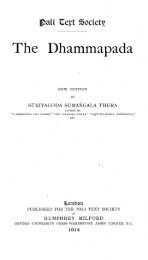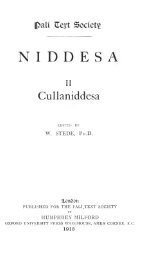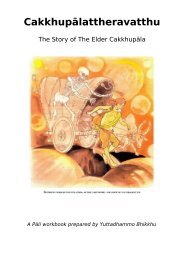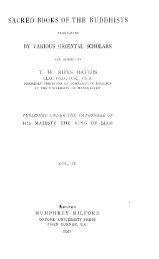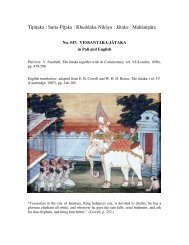Lessons In Practical Buddhism - Sirimangalo.Org
Lessons In Practical Buddhism - Sirimangalo.Org
Lessons In Practical Buddhism - Sirimangalo.Org
Create successful ePaper yourself
Turn your PDF publications into a flip-book with our unique Google optimized e-Paper software.
obtaining, or not obtaining. Sometimes they will be aware of<br />
craving or aversion. By breaking experience up into its parts<br />
like this and seeing each part for what it is – not me, not<br />
mine, not good, not bad – we can break the cycle of<br />
addiction at every moment and eventually reprogram the<br />
habits of the mind.<br />
When we watch our experience carefully and develop<br />
moment to moment clear awareness, this is the cultivation of<br />
wisdom. When we see something, the truth is that it’s only<br />
seeing; it’s neither good nor bad. There’s no phenomenon<br />
that is intrinsically good or bad, after all; it’s simply because<br />
of our misunderstanding and the expectations it brings –<br />
expecting certain sights, sounds, or experiences to bring<br />
pleasure or displeasure – that we give rise to craving.<br />
Craving is divided into three types by the Buddha – craving<br />
for sensuality, craving for being, and craving for non-being.<br />
Craving for sensuality is the desire to see, hear, smell, taste<br />
and feel pleasant experiences. Craving for being is the<br />
desire for something to arise and craving for non-being is the<br />
desire for something to cease. Altogether, they simply mean<br />
wanting – wanting to obtain an experience in the case of<br />
those recognized as bringing pleasure and wanting to avoid<br />
or suppress an experience in the case of those recognized as<br />
bringing suffering.<br />
Because of our ignorant conceptions, conceiving experience<br />
as more than simply what it is, we will inevitably put value<br />
judgements on it. When we see someone, we immediately<br />
give rise to some preconceived notion in regards to them –<br />
getting angry and upset because we don’t like them or<br />
attracted and pleased because we do. Because we aren’t<br />
able to see the person as simply a collection of momentary<br />
experiences, we give rise to craving, and this is what gets us<br />
into trouble, because this is how addiction works.<br />
If addiction didn’t cause trouble, we wouldn’t have to look for<br />
a way out of it. The truth of reality, though, is that our<br />
cravings drag us into a cycle of addiction from which it is<br />
very difficult to break free. This is according to the next link<br />
in the teaching, that craving leads to clinging. Craving<br />
wouldn’t be a problem if it didn’t lead to addiction, a habitual<br />
clinging to the object out of desire or aversion. People who<br />
118



